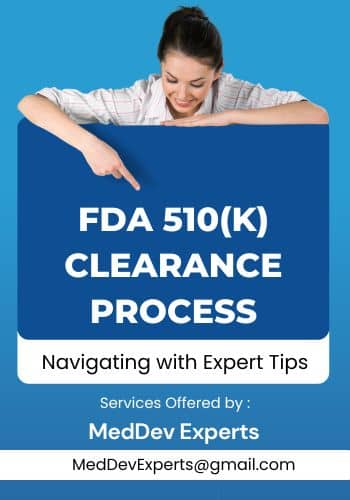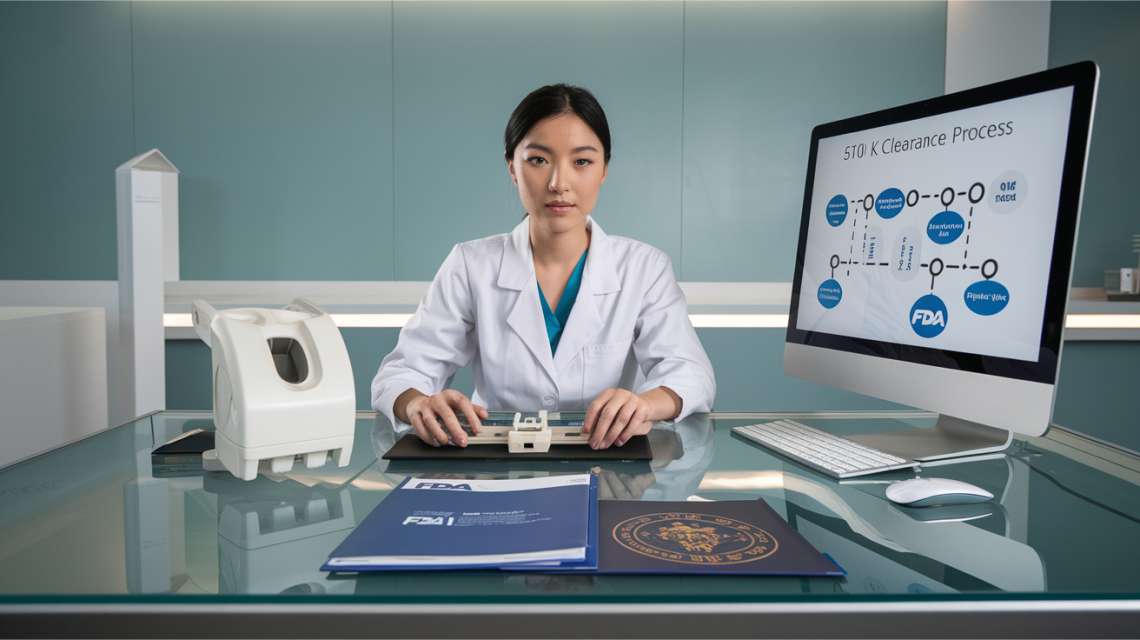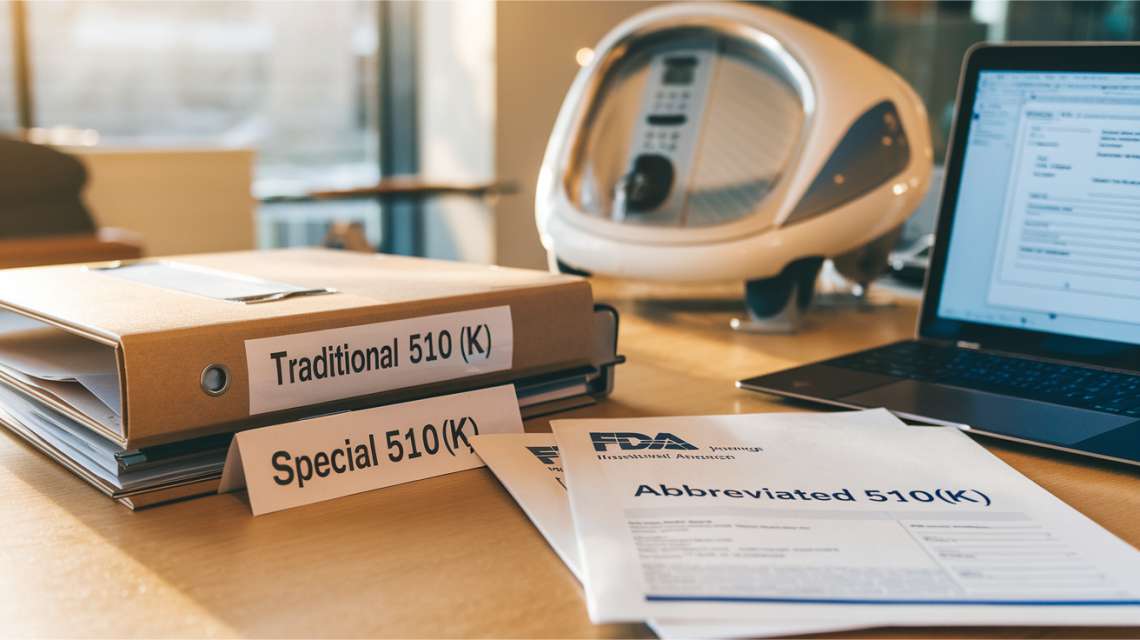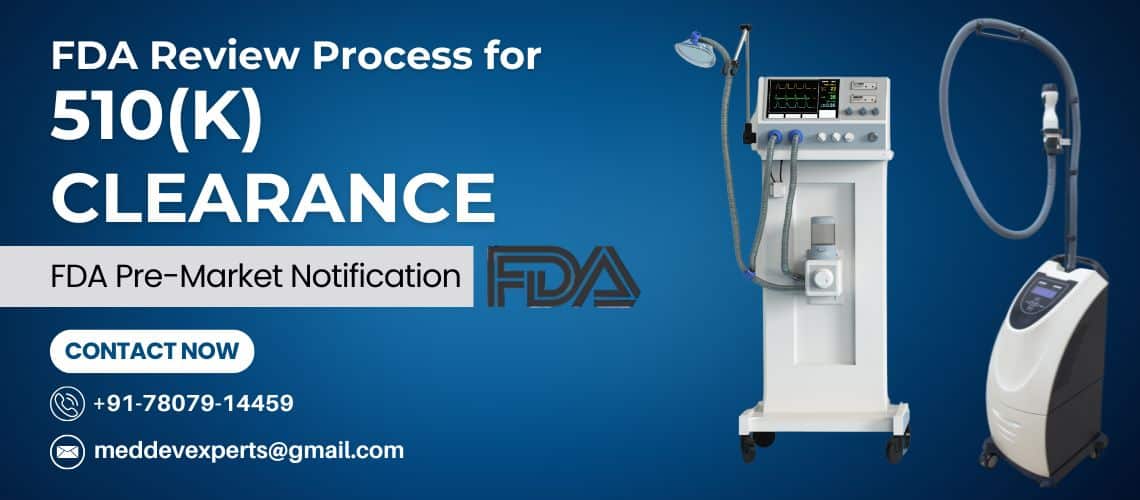FDA 510(k) Clearance Process: Navigating with Expert Tips
In the high-stakes world of medical device development, bringing your innovation to market can feel like navigating a complex maze of regulatory requirements. The FDA 510(k) clearance process stands as a critical gateway for thousands of devices each year—one that can make or break your product’s future. With shifting regulatory expectations and substantial financial investments on the line, even experienced manufacturers can find themselves overwhelmed by the intricacies of demonstrating “substantial equivalence” to predicate devices.
Are you preparing for your first 510(k) submission? Or perhaps you’ve faced delays or rejections in the past? You’re not alone. From inadequate predicate device selection to insufficient documentation, many manufacturers struggle with common pitfalls that can add months to their timeline or result in outright denial. Yet understanding this pathway isn’t just about compliance—it’s about strategically positioning your device for commercial success in both domestic and global markets.
This comprehensive guide with with expert tips walks you through every critical step of the 510(k) clearance process, from understanding device classification and preparing a robust application to navigating FDA reviews and fulfilling post-clearance obligations. We’ll explore the nuances of predicate device selection, unpack the different types of submissions, and share proven strategies for overcoming the most common challenges that delay market entry.
Understanding Medical Device Classification System
Class I, II, and III devices explained
The FDA classifies medical devices into three categories based on their risk level and the regulatory controls necessary to ensure their safety and effectiveness:
Class I Devices: These are low-risk devices subject to the least regulatory control. Approximately 74% of Class I devices are exempt from premarket notification (FDA 510k Clearance). Examples include basic medical instruments like clinical mercury thermometers (21 CFR 880.2920).
Class II Devices: These moderate-risk devices typically require FDA 510(k) clearance before marketing. They must demonstrate substantial equivalence to an existing legally marketed device.
Class III Devices: These high-risk devices are subject to the most stringent regulatory controls, often requiring premarket approval (PMA) rather than FDA 510(k) clearance.
Which devices typically require FDA 510(k) clearance
According to 21 CFR 807, Subpart E, manufacturers must submit a 510(k) premarket notification in the following cases:
Introducing a device that has not been previously marketed
Reintroducing a device with modifications that may affect its safety or effectiveness
Changes in design, materials, chemical composition, energy source, manufacturing processes, or intended use
Most Class II devices require FDA 510(k) clearance, while many Class I devices are exempt. Class III devices typically require more rigorous premarket approval processes rather than FDA 510(k) clearance.
Impact of classification on regulatory requirements
The classification of a medical device directly determines the level of regulatory scrutiny it faces:
- Documentation Requirements: Higher-risk classifications require more comprehensive documentation and testing data
- Review Timeline: More complex classifications generally face longer review periods
- Post-Market Controls: Higher-risk devices face more stringent post-market surveillance requirements
To determine a device’s classification, manufacturers can:
Search the classification database using the device name
Navigate to the specific medical specialty panel if known
Review the Code of Federal Regulations (CFR) which lists classified devices with 7-digit regulation numbers
Submit a formal 513(g) Request to the FDA for classification determination (subject to user fees, with reduced fees available for small businesses)
With this understanding of device classification, we’ll next explore the concept of substantial equivalence, which forms the foundation of the 510(k) clearance process.
The Concept of Substantial Equivalence
Now that we understand how the FDA classifies medical devices, let’s explore the fundamental concept that makes the 510(k) clearance process possible: substantial equivalence.
Defining substantial equivalence in the FDA context
Substantial equivalence (SE) forms the cornerstone of the FDA’s Premarket Notification [FDA 510(k) Clearance] process. For a new medical device to gain market approval without going through the more rigorous Premarket Approval (PMA) process, manufacturers must demonstrate that their device is substantially equivalent to a legally marketed predicate device.
A device is considered substantially equivalent when it has:
The same intended use as the predicate device
Similar technological characteristics to the predicate device OR
Different technological characteristics but doesn’t raise new questions of safety and effectiveness
It’s important to note that substantial equivalence doesn’t require devices to be identical. Rather, the FDA is looking for comparable safety and effectiveness profiles between the new and predicate devices.
How to identify appropriate predicate devices
Finding the right predicate device is crucial for a successful 510(k) submission. Appropriate predicate devices can include:
- Devices previously cleared through the FDA 510(k) Clearance process
- Preamendments devices (marketed before May 28, 1976)
- Downclassified Class III devices
- 510(k) exempt devices that comply with the Federal Food Drug & Cosmetic Act
The FDA maintains a 510(k) database that’s updated monthly, making it a valuable resource for identifying potential predicates. Effective searching requires:
Understanding your device’s classification and product codes
Using precise search terms
Recognizing that the database contains original application information and may not reflect current ownership or trade name changes
Manufacturers should focus on identifying a primary predicate device that best matches their new device. While multiple devices may be referenced to support specific claims, the FDA discourages the use of “split predicates,” which don’t align with regulatory standards.
Analyzing Summaries of Safety and Effectiveness Data
Once potential predicate devices are identified, manufacturers must analyze their Summaries of Safety and Effectiveness Data. This analysis helps determine if the predicate is truly appropriate for comparison and identifies what testing may be required to demonstrate substantial equivalence. The analysis should focus on:
Intended use statements
Design features and materials
Performance characteristics
Safety profiles
For preamendments devices (those legally marketed before 1976), it’s critical to verify that their intended use hasn’t changed significantly. If the intended use has changed, a new 510(k) submission would be required, potentially affecting their suitability as predicates.
With this understanding of substantial equivalence established, we can now examine the different types of FDA 510(k) submissions that manufacturers can pursue based on their device’s characteristics and similarities to existing predicates.
Types of 510(k) Submissions
Now that we understand the concept of substantial equivalence, let’s explore the different types of FDA 510(k) submissions available to medical device manufacturers seeking FDA clearance.
A. Traditional 510(k): When to use and requirements
The Traditional 510(k) is the original submission type established under 21 CFR 807. This option applies to both new devices and modifications to previously cleared devices. When submitting a Traditional 510(k), manufacturers must demonstrate substantial equivalence to a legally marketed predicate device.
Key features of Traditional 510(k) clearance:
FDA typically reviews these submissions within 90 days
Subject to an acceptance review per the FDA’s Refuse to Accept Policy
Requires comprehensive documentation as outlined in 21 CFR 807.87
Necessitates identification of a primary predicate device that closely resembles the new device in terms of intended use and technology
B. Special 510(k): Streamlined process for modifications
The Special 510(k) program, refined in 2019, offers a faster pathway specifically designed for manufacturers making changes to their own existing devices. This option is available when:
The evaluation methods for assessing changes are well-established
The review can be based on design control summary or risk analysis
Key features of Special 510(k):
FDA reviews these submissions within an expedited 30-day timeframe (after acceptance)
Not suitable for devices involved in biological product manufacturing at the point of care, due to lack of established evaluation methods
Focuses on changes to previously cleared devices
C. Abbreviated 510(k): Leveraging guidance documents and standards
The Abbreviated 510(k) is appropriate when submissions rely on:
- FDA guidance documents
- Compliance with special controls
- Adherence to voluntary consensus standards
This submission type contains the same essential elements as the Traditional 510(k) but allows manufacturers to streamline the review process by providing summary reports. The FDA reviews Abbreviated 510(k) submissions within 90 days, following an acceptance review.
It’s important to note that despite the different submission types, all 510(k)s share the same user fee structure. Beginning October 1, 2023, submissions must be made electronically via the eSTAR platform, with limited exceptions.
With a clear understanding of the available 510(k) submission types, we can now examine how to prepare a comprehensive 510(k) application that meets FDA requirements.
Preparing a Comprehensive 510(k) Application
Now that we’ve explored the types of FDA 510(k) submissions available, let’s focus on how to prepare a comprehensive application that meets FDA requirements.
Essential Documentation Requirements
When preparing your 510(k) submission, remember that no specific form is required. Instead, you must provide information as outlined under 21 CFR 807.87. All submissions, regardless of type (Traditional, Special, or Abbreviated), must demonstrate substantial equivalence (SE) to a legally marketed predicate device. It’s crucial to identify a primary predicate device that closely resembles your new device in terms of both intended use and technology. When referencing predicates, include specific predicate device numbers to facilitate the review process.
Product Descriptions and Labeling Considerations
Your application must include comprehensive product descriptions that clearly explain your device’s functionality, intended use, and technological characteristics. Labeling information is a critical component that the FDA will scrutinize closely. Ensure that all product descriptions align precisely with your identified predicate device to strengthen your substantial equivalence claim.
Performance Data and Testing Requirements
Device-specific guidance documents provide crucial information for preparing your testing documentation. Consult these resources to understand the specific performance data required for your device category. The FDA evaluates this data to confirm your device performs as intended and is substantially equivalent to the predicate device. Performance testing should address safety, effectiveness, and any technological differences between your device and the predicate.
Avoiding Common Documentation Pitfalls
Common pitfalls that delay 510(k) clearance include:
Incomplete submissions that trigger a Hold Letter, giving you only 180 days to resolve issues before withdrawal
Failure to properly identify appropriate predicate devices
Submitting via incorrect channels (as of October 1, 2023, submissions must be made electronically via the eSTAR platform, with limited exceptions)
Not retaining a copy of your submission for your records
Submitting user fees incorrectly (fees should be submitted separately from the application)
Utilize the FDA’s available resources, including online tracking capabilities and guidance documents, to navigate the submission process effectively.
With a well-prepared 510(k) application in hand, the next step is understanding how to navigate the FDA review process, which involves several stages from submission to final decision.
Navigating the FDA Review Process
After preparing a comprehensive 510(k) application with all necessary documentation, you’ll enter the FDA review process. Understanding this process is crucial for proper planning and successful navigation through regulatory requirements.
Timeline Expectations and Review Stages
The FDA review process follows a structured timeline with specific stages:
Initial Processing: Upon submission via eSTAR or eCopy, the FDA assigns a unique 510(k) number (K followed by six digits) and verifies payment of user fees and submission format validity.
Acknowledgment Letter: Once valid submissions are accepted, the FDA sends this letter confirming receipt and providing the 510(k) number for future correspondence.
Acceptance Review (15 days): The Lead Reviewer assesses the submission’s completeness using established guidelines. If not accepted, submissions are placed on RTA Hold for up to 180 days to address deficiencies.
Substantive Review: Accepted submissions undergo thorough technical review. The 2021 performance goal mandates that 95% of Traditional 510(k) submissions be reviewed within 90 FDA days.
Decision: The FDA ultimately issues either a substantial equivalence (SE) determination (clearance) or not substantially equivalent (NSE) finding.
Effective Communication Strategies with FDA Reviewers
Maintaining proper communication with FDA reviewers is essential:
Always reference your assigned 510(k) number in all communications
Respond promptly to any FDA inquiries
Utilize the Interactive Review phase effectively to address minor issues quickly
Track your submission progress through available online resources provided by the FDA
Prepare for the Substantive Interaction phase, which typically occurs within 60 days
Addressing FDA Questions and Concerns
When facing FDA questions or concerns:
Additional Information (AI) Requests: If significant deficiencies are identified, the FDA issues an AI Request. You must respond within 180 days, with no extensions permitted.
Response Strategy: Provide comprehensive responses addressing all identified deficiencies in the AI Request.
Missed MDUFA Communication: If the FDA cannot reach a decision within the 90-day timeframe, they issue this communication to discuss outstanding issues.
Hold Letters: If issues with submission format or fee payment arise, the FDA issues Hold Letters, giving you 180 days to resolve issues before withdrawal.
With a clear understanding of the FDA review process, you’ll be better prepared to address common challenges that may arise during your submission, which we’ll explore in the next section.
Common Challenges and How to Overcome Them
Now that we’ve navigated through the FDA review process, it’s important to understand the common challenges that manufacturers face during the 510(k) submission and how to effectively overcome them.
A. Insufficient predicate device identification
One of the most significant hurdles in the 510(k) process is properly identifying suitable predicate devices. Without an appropriate predicate, demonstrating substantial equivalence becomes virtually impossible. The FDA 510(k) clearance database serves as a valuable resource for identifying predicates, but many manufacturers struggle with effectively utilizing this tool. To overcome this challenge:
- Conduct thorough searches in the FDA database for similar products
- Review entry details carefully to ensure alignment with your device’s intended use
- Download and analyze documentation of potential predicates to understand how they successfully achieved clearance
B. Documentation inadequacies
The 510(k) process demands meticulous documentation, and inadequacies in this area frequently lead to delays or rejections. As highlighted by Tim M. Lohnes, a senior regulatory consultant with over 25 years of experience, manufacturers should apply the same dedication to the 510(k) process as they invested in device development. Common documentation issues include:
- Incomplete technical specifications
- Insufficient test data demonstrating safety and effectiveness
- Poorly organized submissions that fail to follow FDA guidelines
- Lack of clarity in explaining substantial equivalence
To address these issues, maintain comprehensive records throughout the development process and consider consulting with regulatory experts who can review documentation before submission.
C. Compliance misinterpretations
Navigating the complex regulatory landscape presents another significant challenge. Compliance misinterpretations can lead to prolonged approval timelines, with the average decision time extending to approximately 147 days—well beyond the FDA’s target of 90 days. These extensions typically result from requests for additional information due to compliance misunderstandings. Strategies to overcome compliance challenges include:
- Engaging in early consultations with the FDA
- Employing experienced regulatory consultants familiar with current requirements
- Staying updated on evolving regulations that might affect your submission
- Maintaining clear communication channels with FDA reviewers throughout the process
With these challenges addressed, manufacturers will be better positioned to fulfill their post-clearance obligations, which we’ll explore in the next section. Understanding these ongoing responsibilities is crucial for maintaining compliance and ensuring continued market access after successfully navigating the 510(k) process.
Post-Clearance Obligations and Considerations
Now that we have addressed the common challenges in the FDA 510(k) clearance process, it’s crucial to understand that obtaining clearance is not the end of regulatory obligations. Device manufacturers must maintain compliance with several post-clearance requirements to ensure continued market access.
Post-market surveillance requirements
After receiving 510(k) clearance, manufacturers must implement comprehensive tracking systems for their medical devices. This surveillance is critical for monitoring device performance in real-world settings. The FDA requires manufacturers to:
Establish and maintain systems to track device distribution
Monitor device performance across various clinical settings
Collect data on device usage and outcomes
Implement quality control measures to ensure continued device safety
These surveillance activities help identify potential issues that might not have been apparent during the premarket review process and allow for timely interventions when necessary.
Reporting obligations to maintain compliance
The FDA mandates specific reporting requirements to maintain compliance post-clearance:
Report device malfunctions that could potentially lead to serious injury or death
Submit reports of serious injuries or fatalities associated with the device
Register all production and distribution establishments with the FDA
Conduct mandatory postmarket surveillance studies as required under section 522
Complete any post-approval studies mandated for specific applications (PMA, HDE, or PDP)
Failure to meet these reporting obligations may result in FDA enforcement actions, including potential withdrawal of market authorization.
Balancing FDA requirements with payor expectations
While ensuring regulatory compliance, manufacturers must also consider the expectations of payors:
Maintain documentation that demonstrates ongoing safety and effectiveness
Balance post-market surveillance costs with reimbursement considerations
Develop strategies to address both FDA requirements and market access needs
Utilize FDA resources such as guidance documents and safety communications
This balance is particularly important as device modifications or updates may require new 510(k) submissions if they significantly affect safety or effectiveness through changes in design, materials, chemical composition, energy source, manufacturing processes, or intended use.
With these post-clearance obligations in mind, next we’ll explore Global Market Considerations and how FDA clearance aligns with international regulatory requirements.
Global Market Considerations
Now that we understand the post-clearance obligations for medical device manufacturers, let’s explore how FDA 510(k) clearance impacts global market strategies and international regulatory considerations.
How 510(k) clearance affects international market access
The FDA 510(k) regulatory pathway not only provides clearance for marketing medical devices in the United States but can also significantly influence a manufacturer’s ability to enter international markets. Many countries recognize FDA clearance as a benchmark for safety and effectiveness, potentially streamlining approval processes in foreign jurisdictions. Having achieved 510(k) clearance, manufacturers can leverage this regulatory milestone when pursuing approvals in other countries, potentially reducing the documentation burden and accelerating international market entry.
However, it’s important to note that while FDA clearance is respected globally, it does not automatically grant access to foreign markets. Each country maintains its own regulatory requirements that must be satisfied independently.
Special considerations for India, Japan and China markets
When targeting India, Japan and China—two of the world’s largest medical device markets—manufacturers must navigate unique regulatory landscapes that differ from the FDA process.
Japan’s regulatory system requires additional documentation and often supplementary testing beyond what was submitted for FDA clearance. Japanese authorities may request country-specific clinical data and more comprehensive technical documentation than what was required for the U.S. submission.
Similarly, China’s regulatory framework has distinct requirements, including localized testing and documentation. Chinese authorities often require device testing in domestic laboratories and may impose additional clinical evaluation requirements, even for devices that have achieved FDA clearance.
If your device is cleared by FDA, you can register your device in India without conducting any clinical trial.
Manufacturers planning global market entry should account for these regional differences early in their regulatory strategy to avoid delays and unexpected costs.
As you consider your global market strategy, it’s important to have experienced regulatory partners who understand the intricacies of international medical device compliance. In the next section, we’ll explore why choosing MedDev Experts for your 510(k) needs can provide valuable advantages throughout your regulatory journey.
Why Choose MedDev Experts for Your 510k Needs
Unparalleled Expertise in FDA Submissions
When you’re navigating the complex 510(k) clearance maze, working with a team that lives and breathes FDA submissions makes all the difference. At MedDev Experts, we don’t just understand the process – we’ve mastered it through hundreds of successful submissions.
Comprehensive Support From Start to Finish
The 510(k) journey isn’t a single task – it’s dozens of critical steps that need perfect execution. Our team handles everything:
Strategy development tailored to your specific device
Gap analysis to identify potential roadblocks early
Predicate device selection that strengthens your case
Document preparation that meets exacting FDA standards
Regulatory correspondence management
Post-submission support
Your Regulatory Partner, Not Just a Consultant
Working with MedDev Experts means gaining a partner invested in your success. We don’t drop a pile of documents in your lap and disappear. We’re with you from initial assessment through market launch, providing the expertise, support, and confidence you need to navigate the FDA process successfully.
Navigating the FDA 510(k) clearance process requires a comprehensive understanding of device classification, substantial equivalence, submission types, and regulatory requirements. Successfully traversing this pathway demands meticulous preparation, clear communication with FDA reviewers, and awareness of evolving guidelines. From selecting appropriate predicate devices to addressing post-clearance obligations, each step plays a critical role in bringing medical devices to market efficiently while ensuring patient safety.
The journey doesn’t end with FDA clearance—manufacturers must remain vigilant about post-market surveillance, reporting obligations, and global market considerations. Whether you’re facing challenges with documentation, predicate device selection, or compliance interpretations, expert guidance can make the difference between delays and successful market entry. By prioritizing regulatory compliance and leveraging specialized expertise, medical device manufacturers can navigate the complex 510(k) landscape with confidence, ultimately benefiting both their business objectives and the patients their innovations aim to serve.









